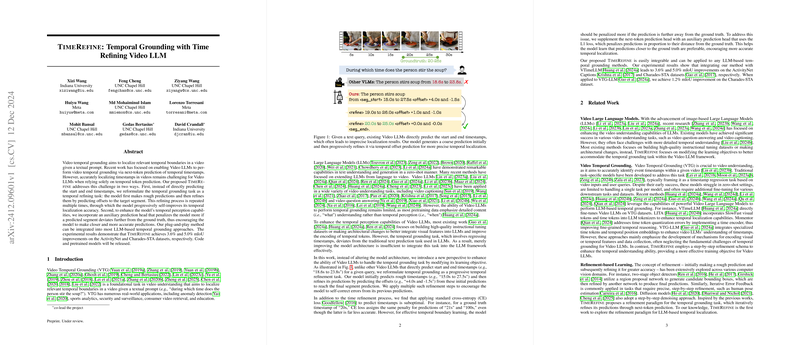TimeRefine: Enhanced Temporal Grounding in Video LLMs
The paper under review introduces TimeRefine, an innovative approach to improve the temporal grounding capability of Video LLMs (Video LLMs). Temporal grounding refers to the task of localizing specific time segments in a video that correlate with textual prompts. Although recent endeavors have enabled Video LLMs to predict temporal boundaries, pinpoint accuracy remains challenging. TimeRefine circumvents the limitations of existing methods by redefining the task as an iterative temporal refinement exercise, presenting a novel learning focus that enhances temporal prediction accuracy.
Methodology
TimeRefine fundamentally reimagines the task of temporal grounding from a direct prediction model to a progressive, step-by-step refinement paradigm. Instead of predicting start and end timestamps in one step, the model iteratively refines its predictions, each iteration driven by offset predictions that correct the timestamps step by step. This iterative self-improvement uses multiple rounds to refine predictions, thus mimicking human-like coarse-to-detail temporal localization.
In addition to the iterative approach, an auxiliary prediction head is introduced. This head penalizes the model in proportion to the deviation of its predictions from the ground truth, employing L1 loss to signal that predictions closer to the true time frame are preferable. This mechanism complements the original token prediction framework and enhances the temporal focal ability of the Video LLMs.
Results
TimeRefine is validated on two datasets: ActivityNet Captions and Charades-STA. In these experiments, the method achieved significant improvements in the mean Intersection over Union (mIoU)—3.6% on ActivityNet and 5.0% on Charades-STA when integrated with VTimeLLM, a pre-existing temporal grounding framework. Furthermore, it elevated recall metrics at varying thresholds ([email protected], [email protected], [email protected]), validating the enhanced precision in temporal localization.
Comparisons and Implications
The iterative refinement approach and auxiliary head together make TimeRefine agnostic to core architecture changes, allowing it to be integrated seamlessly with other LLM-based VTG methods. Application to VTG-LLM further demonstrated its efficacy, reflecting a 1.2% mIoU improvement on Charades-STA. Against competing methods—both general Video LLMs and those specializing in VTG—TimeRefine showed leading performance on most counts, emphasizing its suitability as a plug-and-play improvement module.
This incremental yet markedly effective refinement strategy marks a departure from reliance on data curation and architectural modification strategies previously dominating the field. The implications span both practical applications—such as video surveillance, sports analytics, and consumer video retrieval—and further theoretical explorations into the interplay between iterative refinement and network architecture in prediction tasks.
Future Directions
While TimeRefine advances current methodologies in temporal grounding, it also highlights new avenues for exploration. Its iterative modeling could be further optimized, potentially reducing the number of necessary prediction steps with the development of more complex refinement schemas. Additionally, the auxiliary head introduces an intriguing opportunity to investigate dual-head architectures' broader application in LLMs, perhaps extending beyond temporal tasks to other regression-focused initiatives within AI and video understanding.
Overall, TimeRefine represents a judicious blend of task reframing, model agnosticism, and lateral thinking in the pursuit of more precise and reliable temporal grounding in video data. Future research might build upon these principles to extend improvement towards a wider array of applications and refine the machinery of LLMs dealing with continuous variable predictions.
